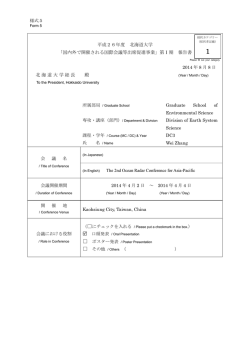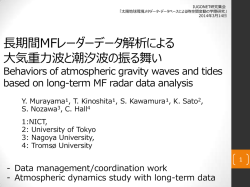
IMAP/VISI と北海道 HF レーダーによる同心状大気光
IMAP/VISI と北海道 HF レーダーによる同心状大気光と MSTID 同時観測 坂野井健 1、西谷望 2、堀智昭 2、斎藤昭則 3、山崎敦 4、秋谷祐介 3、穂積裕太 3、 江尻省 5、大塚雄一 2、ペルウィタサリ・セプティ 1、津川卓也 6 東北大学理学研究科 名古屋大学 STE 研究所 3 京都大学理学研究科 4 JAXA 宇宙科学研究所 5 国立極地研究所 6 情報通信研究機構 1 2 Coordinated observation of concentric gravity waves and MSTID using IMAP/VISI and Hokkaido HF radar Takeshi Sakanoi1, Nozomu Nishitani2,Tomoaki Hori2, Akinori Saito3, Atsushi Yamazaki4, Yusuke Akiya2, Yuta Hozumi2, Mitsumu K. Ejiri5, Yuichi Otsuka2, Septi Perwitasari1 and Takuya Tsugawa6 1 Gtaduate School of Science, Tohoku University 2 STEL, Nagoya University 3 Gtaduate School of Science, Kyoto University 4 JAXA, ISAS 5 National Institute of Polar Research 2 National Institute of Information and Communication Technology We report a case study obained from the coordinated IMAP/VISI from space and the Hokkaido HF radar observation of atmospheric gravity waves (AGWs) and MSTID. IMAP/VISI is a visible imaging spectrometer on the international space station (ISS) (~400 km altitude) and measures the O2 A-band at 762nm emission at altitude of ~95 km. We obtain the linescanning of horizontal distribution of airglow from VISI since VISI is operated continuously in the wide geographycal latiude range between +51 deg. and – 51 deg, and its field-of-view of 90 deg. directed perpendicular to the ISS orbital track of which mapped width at the E-region height is ~600 km. Since the successful launch of IMAP in August 2012, we usually operate VISI approximately 15 orbits a day in the night side hemisphere. We found that meso-scale (~10 - 50 km) wave pattern is always seen in the airglow emission at O2 A-band mainly at the whole latitude range, including more than 180 concentric gravity wave (CGW) events which suggests that the local generation source generates in the lower-atmosphere the CGW. VISI has two field-of-views, looking 90 deg. forward 90 deg. backward. From the cross-correlation analysis between front FOV data and rear FOV data of which time difference is typically 90 s at the same location in the E-region, we can determine the direction and phase speed of atmospheric gravity wave. On the other hand, a ground-based instrument plays important role for obtaining the time variations of CGW since the horizontal motion of CGW is important to determine the momentum transfer carried by atmoshperic garavity waves. Considering the latitudinal coverage of VISI, the combination between VISI and the Hokkaido HF radar is the most feasible for the conjugate measurement of CGW. We found 37 events on the simultaneous IMAP/VISI and the Hokkaido HF radar measurements of atmoshperic gravity waves during the period from October 2012 to April 2014. In the most cases the AGW pattern taken with VISI is seen only in O2 762 nm emission. Thus, we compared the O2 A-band taken by IMAP/VISI with the near-range echo data obtained in the E-region by the Hokkaido HF radar. From 11 to 15 UT on Feb. 5, 2014, IMAP/VISI measured westward moving concentric gravity waves in the O2 airglow emission. Estimated the phase velocity of gravity waves was westward with the speed of ~160 m/s in the beginning, and then decreased to almost zero at ~15 UT. Simultaneously the Hokkaido HF radar measured south-westward moving successive echo structures in the near-range. We estimated the phase velocity of CGWs along the E-region echo area and along the radar beams from the VISI data, and found that these phase velocities were consistent with those of radar echo structures. During this period, the GEONET GPS data clearly showed the south-westward motion of MSTID in the F-region over Japan. This fact suggests that the F-region MSTID was coupled with the E-region gravity waves. In this presentation we discuss the time varitaion of phase velocities of CGWs and radar echo structures using background wind speed baed on a model analysis.
© Copyright 2025

